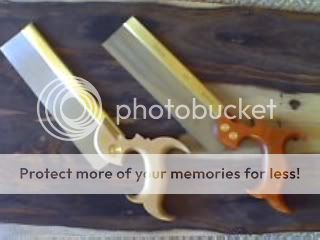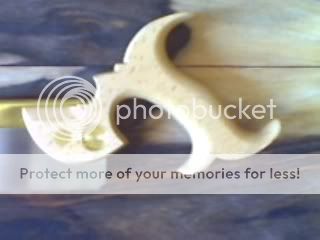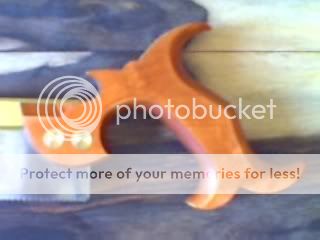dunbarhamlin
Established Member
Ooo - just received one of MikeW's Kenyon dovetail saws.
It cuts like, well, I assume it cuts. I present it to the wood and shortly thereafter find a kerf of the required depth appears. Feels like it just melts through the wood.
The closest tool I have for comparison is an LN small crosscut saw (also pistol grip and same blade size.)
The LN has a heft that lets you know there's something serious on the end of your arm.
The Wenzloff feels like you're not holding anything - point and a kerf magically appears.
Cheap kitchen scales suggest there's actually only an ounce difference between the two (10 1/2 and 11 1/2)
The handles are quite different, with the Wenzloff being noticably more delicate, and the grip more rounded. It would also better suit a smaller hand, as the distant between top and bottom horns is a little less (only a 1/4" - but expect I'll relieve the lower horn at some point)
The grip angles are also different, with the Wenzloff presenting the blade maybe 6 degrees higher. (Of course this comparison may not apply to the LN dovetail)
Handle breadth is around 9/10" on the LN, 8/10" on the Wenzloff, and the grip is almost 1/4" deeper at the apex (mid heel of palm 'lump')
Guess that's enough break time - back to chisel lapping.
Cheers
Steve
It cuts like, well, I assume it cuts. I present it to the wood and shortly thereafter find a kerf of the required depth appears. Feels like it just melts through the wood.
The closest tool I have for comparison is an LN small crosscut saw (also pistol grip and same blade size.)
The LN has a heft that lets you know there's something serious on the end of your arm.
The Wenzloff feels like you're not holding anything - point and a kerf magically appears.
Cheap kitchen scales suggest there's actually only an ounce difference between the two (10 1/2 and 11 1/2)
The handles are quite different, with the Wenzloff being noticably more delicate, and the grip more rounded. It would also better suit a smaller hand, as the distant between top and bottom horns is a little less (only a 1/4" - but expect I'll relieve the lower horn at some point)
The grip angles are also different, with the Wenzloff presenting the blade maybe 6 degrees higher. (Of course this comparison may not apply to the LN dovetail)
Handle breadth is around 9/10" on the LN, 8/10" on the Wenzloff, and the grip is almost 1/4" deeper at the apex (mid heel of palm 'lump')
Guess that's enough break time - back to chisel lapping.
Cheers
Steve








































